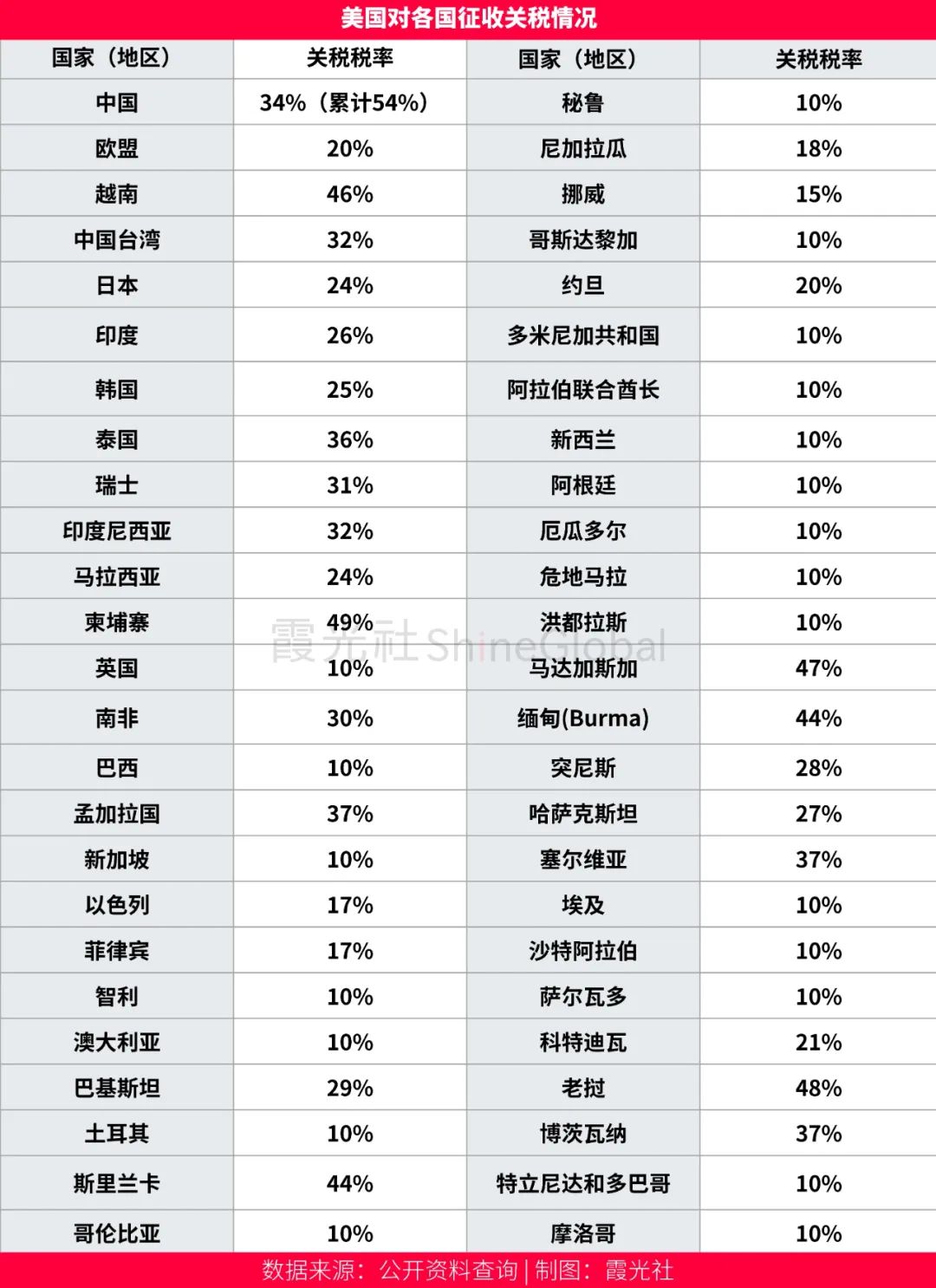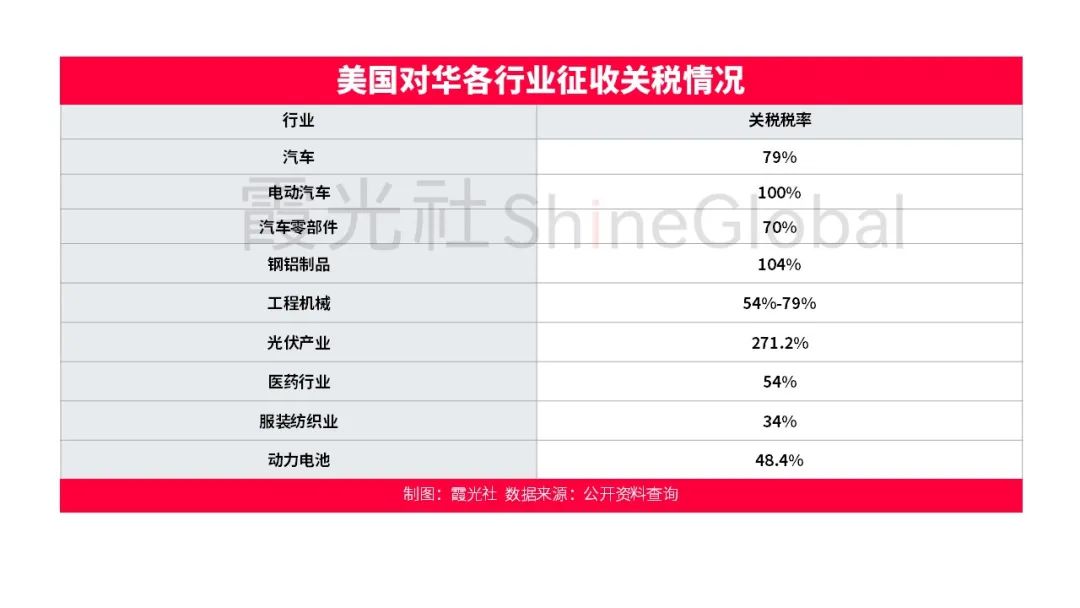Trump's Tariff Storm Approaches: Deciphering Impacts through Two Charts
![]() 04/07 2025
04/07 2025
![]() 547
547

On April 2, 2023, local time, U.S. President Trump unveiled the most extensive tariff measures to date at the White House.
Firstly, a 10% tariff will be imposed on all trading partners, effective April 5. Secondly, a double-digit "reciprocal" tariff will be enforced on dozens of countries deemed by the U.S. government to have unfair trade practices, effective April 9.
These tariffs encompass over 100 trading partners, including the EU, China, the UK, and India. Notably, Chinese goods will face an additional 34% tariff on top of the existing 20%, resulting in a cumulative rate of 54%. Southeast Asian nations such as Vietnam, Myanmar, Laos, and Cambodia will also see tariff rates exceeding 40%. Traditional U.S. allies like the EU, Japan, and South Korea will face tariffs exceeding 20%.
In recent weeks, Trump has been advocating for "reciprocal tariffs," and now the implementation exceeds expectations.
A more intense tariff storm looms, accelerating anti-globalization trends.
Xia Guang She utilizes two charts to illustrate the tariff shifts amidst this storm.

Interpretation:
Revisiting Southeast Asia for overseas ventures is necessary. The U.S. is imposing tariffs on all trading partners, with particularly heavy tariffs on Southeast Asian countries popular among Chinese enterprises, such as Vietnam, Indonesia, Myanmar, and Cambodia. A significant portion of Chinese goods enter the U.S. market via Vietnam and Indonesia. Citibank economists note that U.S. tariffs have severely impacted manufacturing countries in the Asia-Pacific region, including China, Vietnam, and Thailand. Furthermore, the Trump administration has imposed high tariffs on some of Asia's lowest-income countries, such as Laos, Cambodia, Sri Lanka, and Bangladesh, which are favored destinations for the "China+1" strategy. These heavy tariffs render Vietnam, Indonesia, and other locations unsuitable as transshipment hubs for Chinese enterprises, prompting overseas enterprises to reassess their Southeast Asia strategies.
A potential "North American Tariff Alliance" could be the Trump administration's next move. For Canadian and Mexican products exported to the U.S., those meeting the preferential conditions of the USMCA will continue to enjoy tariff exemptions. Mexico may continue to serve as a crucial gateway for Chinese enterprises to access the North American market. However, some analysts suggest that the Trump administration might form a so-called "North American Tariff Alliance," implementing zero tariffs within the NAFTA framework (comprising the U.S., Canada, and Mexico) and subsequently imposing unified external tariffs. This is because if the U.S. imposes tariffs on all countries, Japan, South Korea, the EU, and other U.S. trading partners might utilize Mexico as a key transit node for cargo entering and exiting the U.S. If the "North American Tariff Alliance" plan materializes, Chinese overseas enterprises aiming to reach the North American market via Mexico will be at risk.
Cross-border e-commerce will endure ongoing challenges. Besides increasing tariffs, the Trump administration has also terminated the tax exemption for packages under $800 from China, imposing a 30% tariff or a $25 per-piece tariff (rising to $50 after June 1). Specifically, after the cancellation of T86, packages under $800 must switch to the T11 customs clearance mode, requiring a fixed MPF (merchandise processing fee) of $2.62 per item and a tariff based on the goods' value multiplied by the tax rate. This directly curtails the "small batch, multiple batches" export model via cross-border e-commerce channels.
Localization and branding gain prominence in overseas ventures. In the future, enterprises expanding overseas will prioritize local market development and localization. In terms of business models, overseas enterprises must transition from simple "low-cost export" to a high value-added "branding" strategy to offset tariff-induced cost increases.

Interpretation:
China's photovoltaic industry faces severe tariff pressure. A tariff rate exceeding 270% signifies that the window for Chinese photovoltaic products to export to the U.S. has effectively closed, necessitating a focus on emerging markets.
The automotive and new energy vehicle supply chain has suffered a comprehensive blow. Tariff rates range from nearly 50% to 100% across power batteries, auto parts, complete vehicles, and new energy vehicles. These high tariffs will halt China's auto exports to the U.S. and further propel the decoupling of the auto supply chain between China and the U.S.
Traditional manufacturing industries must urgently expand overseas. The apparel and textile industry, construction machinery, steel, and aluminum products all belong to the manufacturing sector and are under considerable tariff pressure. The general tariff increase renders past transshipment trade unsustainable, necessitating a further move towards overseas diversified markets and deepening local roots.
Tariffs are steering the Sino-U.S. economic and trade relationship towards a "hard decoupling." Citibank analysts assert that the U.S.'s newly announced reciprocal tariff policy, the termination of the "de minimis exemption" policy, fentanyl tariffs, and previously existing tariffs will effectively elevate the U.S. tariff rate on China to 65%. This exceeds Trump's election threats and heightens the likelihood of a "hard decoupling" between the two economies.
For foreign trade enterprises, the new tariff policy presents a triple impact: closing export channels and blocking markets, severing transshipment trade and causing supply chain fragmentation, and pushing up enterprise costs and compressing profit margins with heavy taxes. This combination nearly ends the traditional survival mode of foreign trade enterprises and accelerates the push for Chinese enterprises to establish a new survival model centered on "technological independence + market diversification + regional coordination."








